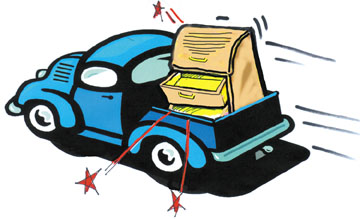
Three specific incidents in recent weeks have reminded me that improvements in handling carry-home purchases and pickups can boost your customer service image. Customers have never been more pressed for time and their expectations have never been higher. Whether they are picking up burgers, fries and drinks at the drive-through lane or buying furniture, customers want it right and want service quickly. As a starter, let me ask you a question. Have you recently looked at pickups and carry-home purchases from your customer's perspective? Here are three examples to think about:
EXPERIENCE #1:
THE REALLY LONG WAIT AT CHECK-OUT
Browsing through a highly respected furniture store while on vacation in August, my wife saw two beautiful picture frames that she thought would make a perfect baby shower gift. We quickly found a salesperson who wrote up the order and accompanied us to an office area where we were introduced to a person to finish up the sale. What should have been a two-minute transaction turned into a twenty-minute process for a sale of less than $150. This retailer had a nationally recognized furniture-retailing package that required us to set up an account complete with all our personal information. Upon completion of this task all the accessory descriptions had to be manually entered before the package could accept our credit card payment. If the items weren't so unique, we would have walked out. Everyone was very polite but the process was simply too time consuming. Every retailer should have a system in place for customers to get their carry-home accessory purchases out the door quickly.
EXPERIENCE #2:
WHAT THE OTHER RETAILER DID
Contrast that experience with this weekend when I bought six five-gallon pails of driveway sealer at the Sears store in our local mall. After making my selection in the department, the salesperson asked if my car was parked close to the customer pickup dock or if a nearby door was more convenient. Either way they would put the containers in my trunk. I had parked near the customer pickup dock and a few minutes later I went to a computer kiosk on the dock and scanned in my sales receipt. I acknowledged what merchandise was being picked up on a touch screen and received a message that my order would be ready within eight minutes. I backed my car up to the pickup door as a warehouse employee was wheeling out the merchandise. I was on my way in less than half the time it took to purchase two picture frames at a furniture retailer. My expectations for this purchase experience were fully met.
EXPERIENCE #3:
HIS DRAWERS DROPPED
While driving home from a Cincinnati Ohio client, I noticed a pickup truck with an attractive roll top desk in the bed, possibly a showroom sample but obviously brand new. The truck exited off the Interstate cloverleaf and on the first curve all the drawers flew open. The lower drawers hit the side while the top drawers extended to the drawer stops. On the next curve they all slammed shut. Honking the horn and blinking my lights, the pickup truck passenger looked back and saw the flying drawers. They waved thanks and pulled off to fix the problem. I have no idea where they purchased the desk but the furniture retailer's warehouse staff should have suggested stretch wrapping or tying the drawers shut.
RATE YOUR OWN
PICKUP PERFORMANCE
Measure your service against the "Ten Steps for Successful Customer Pickups" (that follow) using rankings from 1 for poor to 10 for outstanding. We have seen locations that would earn a score over 90% and others that would fail. Work on improving each step and revisit the area from time to time. After all, if you don't measure performance you can't improve performance.
TEN STEPS FOR SUCCESSFUL CUSTOMER PICKUPS
CUSTOMER ACKNOWLEDGEMENTS
Customers should sign an acknowledgment of their pickup responsibilities. Paperwork for customer pickups should be stamped with a statement limiting your liability. For example: "Please check all merchandise before loading. We will assist in placing your purchases in your vehicle but proper loading is your responsibility and no damage claims will be accepted." (Note: Laws vary from state to state so check with your lawyer.)
CUSTOMER DIRECTIONS
Directions to the customer pickup area should be easy to follow and well marked, whether it is at the retailing location or elsewhere.
CUSTOMER'S FIRST IMPRESSIONS
First impressions of the customer pickup area must be favorable and consistent with your company image. Unfortunately, all to often the warehouse impression is less than satisfactory.
CONVENIENT PARKING
Provide customers with a convenient parking space close to the customer pickup area, preferably covered in areas where weather can be inclement or extremely hot.
CUSTOMER SAFETY
The walkway from entry to the pickup area should not be in warehouse operating areas for safety reasons. Customers need to be restricted to the customer pickup area.
GREETING CUSTOMERS
Customers must be greeted promptly in a friendly manner, advised when their order will be available and directed to the appropriate waiting area.
CUSTOMER COMFORT
While waiting, access to clean restrooms, refreshments and comfortable chairs are desirable. The new single cup brewers eliminate the problems of making coffee and cleanup.
CHECK-UP AND CHECK-OUT
Merchandise should be pulled within the estimated time and customers should be able to check over their furniture purchase before loading their vehicle.
ADVICE & ASSISTANCE
Your uniformed warehouse staff should assist in loading and offer suggestions on proper loading if it appears inadequate.
EXIT STRATEGY
Prior to leaving, customers need to be thanked for their order and asked to visit your company again.
Truck cartoon by Larry Mullins of UltraSales.
Daniel Bolger of The Bolger Group helps companies achieve improved transportation, warehousing and logistics. Questions can be directed to Mr. Bolger care of FURNITURE WORLD at dbolger@furninfo.com.